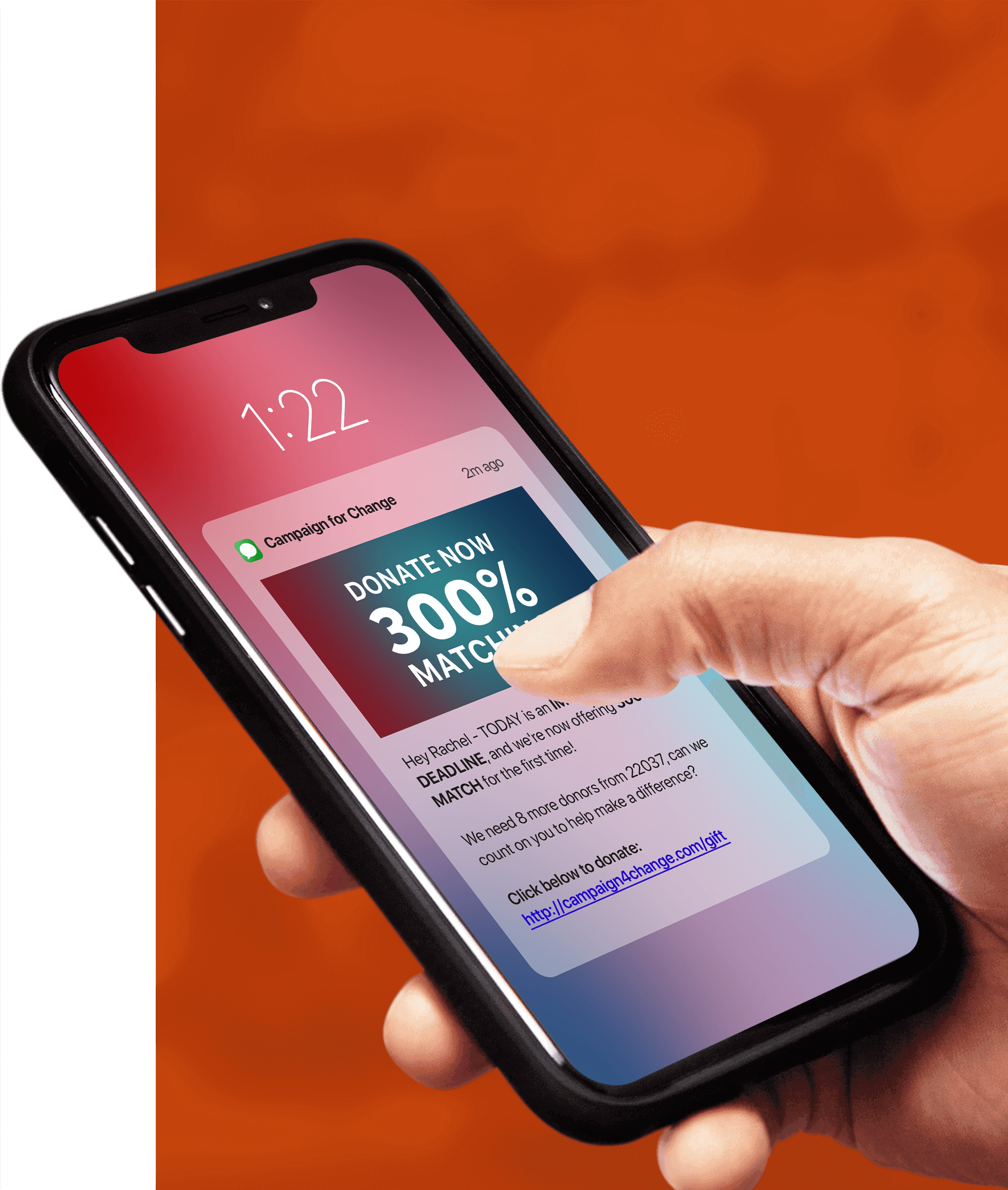
Political text message marketing is one of the most effective ways to fundraise for campaigns, recruit volunteers, increase voter turnout, and communicate directly with supporters. On average, Americans check their phones more than 45 times a day. Compared to email, which has an open rate of around 20%, text message marketing has a mind-blowing open rate of 99%.
However, these days, consumers are savvier than ever and constantly bombarded by marketing strategies. What worked in text marketing five years ago won’t cut it today.
In this blog post, we put together five of the most common text message marketing mistakes to avoid, so you can win elections, quintuple donations, share important updates in real time, and increase support for your political candidate or organization.
Mistake #1: Not Personalizing Text Messages
Research shows that 75% of consumers are more likely to buy from brands that recognize them by name. The same is true for politics. People are more likely to open and engage with your messages when you address them by name. A text message marketing platform like Tatango can help you automatically personalize each message that your political campaign sends to increase your ROI and constituent loyalty.
Additionally, you can use text message marketing to get to know your audience. Invite voters to fill out preference surveys or respond with their zip code, city, state, email address, or most important causes. Using Tatango, you can segment your text message marketing lists based on this information to send more relevant, personalized messages.
Mistake #2: Sending Text Messages at the Wrong Time of Day
There is no rule about the single best time to send SMS text messages. One perk of political SMS marketing is that you can send text messages whenever you have important news to share and can’t wait for social media algorithms to surface them.
What we DO know is that a text message shouldn’t go out too early or too late. Timing is critical to prevent people from unsubscribing and to show respect for your subscribers. Think about it: would you like to receive text messages from a candidate inviting you to donate in the middle of the night OR first thing in the morning before your cup of coffee?
The Telephone Consumer Protection Act (TCPA) strictly states that all marketing text messages should be sent between 8 a.m. and 9 p.m. It’s also wise to avoid peak hours when your subscribers can be overwhelmed with other things and might find your text messages annoying. Monitoring opt-outs each weekday and over the weekend can help you better identify the best time to send out messages to your subscribers.
Using Tatango, you can send your text messages based on a subscriber’s timezone. This ensures you always send at an appropriate time of day, and increase trust between your candidate and your constituents.
Mistake #3: Not Using Multimedia
When it comes to political text messaging, you have two forms of messages at your disposal: MMS messages and SMS messages.
SMS stands for Short Message Service. These messages consist mostly of plain text and can contain no more than 160 characters. They are an excellent option when you want to keep messages short, clear, and to the point.
MMS stands for Multimedia Messaging Services. These messages can contain up to 5,000 characters, a subject line, and features such as images, GIFs, videos, and audio files. Political groups love MMS messages because they help bring their messages to life. You can show photos of your candidate, campaign slogans, behind-the-scenes at events, and advertisements soliciting donations. You can also share much more about important issues with 5,000 characters, as opposed to 160 characters.
Because of its eye-catching possibilities, MMS is an extremely popular text messaging format. Brands that incorporate MMS in their text messaging campaigns have generated a 6,000% increase in ROI. Adding visual content entices subscribers to take a second look at your text message, and additional characters help you better explain to supporters why they should take action.
Using Tatango, you can A/B test your MMS messages to see which images, messages, and even subject lines get the most attention. Going forward, you can apply these learnings to increase donations, improve open rates, and grow your followers.
P.S. Check out this handy MMS sizing guide to design more effective text images.
Mistake #4: Using a Shared Short Code
When selecting a phone number for your political group, make sure you ask your SMS marketing provider about a dedicated short code. There are two options you hear about in this industry: shared short codes and dedicated short codes.
Shared short codes are numbers shared by multiple brands. They are cheaper, however they are much riskier, because how one brand uses the short code affects ALL the other brands. If a brand gets shut down for not following the rules, then YOU get shut down. In the heat of election season, this could mean the difference between meeting a fundraising deadline or coming up short… or even winning and losing an election.
In fact, the SMS industry is so opposed to shared short codes for political groups that they now require political campaigns to use their own dedicated short codes. This is a smart move, not only for the reasons above, but for a branding perspective. The more a consumer recognizes your number, the more likely they are to subscribe and engage. You can promote your dedicated short code on all of your campaign materials—from podiums to flyers to t-shirts and more—and you never have to risk getting shut down for someone else’s mistakes.
Here at Tatango, political organizations often come to us asking if they can migrate their existing subscribers to a new short code. The answer is a resounding YES. It’s super easy, even if your current SMS provider wants you to think otherwise. Check out our free guide breaking down the process of short code migration.
Mistake #5: Forgetting Opt-In Incentives
Text message marketing is strictly a subscriber-only communication tool. As a political organization, you can’t send messages to people who haven’t opted in to your text messaging campaign. The Federal Communications Commission (FCC) regulates text message marketing. Make sure you’re aware of their strict guidelines about opt-in processes before sending bulk messages to potential supporters.
If your subscriber list is growing slower than you’d like, consider adding an incentive for constituents to opt in to your campaign. Research shows that opt-in incentives are powerful for growing your subscriber list, increasing text message subscribers by 520%. In fact, at Tatango, we’ve seen clients generate 300,000 subscribers in just three days using opt-in incentives!
Some think that subscribers will only opt in to your list to get the incentive and then opt out. However, that’s largely NOT the case. Based on our analysis, the average opt-out rate after receiving an opt-in incentive is only 2.3%. So, for every 100 people who subscriber, on average 98 people stay on your list.
Create Your Winning Political SMS Marketing Campaign Today
Now that you know what NOT to do, it’s time to apply this knowledge to create campaigns that rapidly increase your political donations, followers AND voters. Schedule a time to chat with an SMS marketing professional to strategize about how text messaging can lead your political organization to victory.

